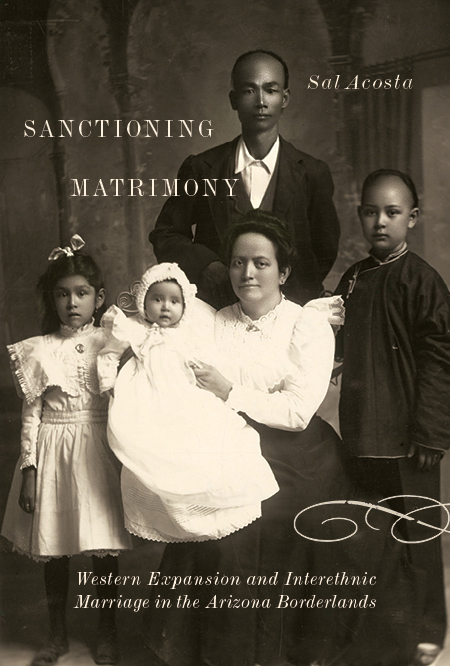Sanctioning Matrimony
Western Expansion and Interethnic Marriage in the Arizona Borderlands
Paperback ($30.00), Hardcover ($57.00), Ebook ($57.00)
Buy
Marriage, divorce, birth, baptism, and census records are the essential records of a community. Through them we see who marries, who divorces, and how many children are born. Sal Acosta has studied a broad base of these vital records to produce the largest quantitative study of intermarriage of any group in the West. Sanctioning Matrimony examines intermarriage in the Tucson area between 1860 and 1930. Unlike previous studies on intermarriage, this book examines not only intermarriages of Mexicans with whites but also their unions with blacks and Chinese.
Following the Treaty of Mesilla (1853), interethnic relationships played a significant part in the Southwest. Acosta provides previously unseen archival research on the scope and tenor of interracial marriages in Arizona. Contending that scholarship on intermarriage has focused on the upper classes, Acosta takes us into the world of the working and lower classes and illuminates how church and state shaped the behavior of participants in interracial unions.
Marriage practices in Tucson reveal that Mexican women were pivotal in shaping family and social life between 1854 and 1930. Virtually all intermarriages before 1900 were, according to Acosta, between Mexican women and white men, or between Mexican women and blacks or Chinese until the 1920s, illustrating the importance of these women during the transformation of Tucson from a Mexican pueblo to an American town.
Acosta’s deep analysis of vital records, census data, and miscegenation laws in Arizona demonstrates how interethnic relationships benefited from and extended the racial fluidity of the Arizona borderlands.
Following the Treaty of Mesilla (1853), interethnic relationships played a significant part in the Southwest. Acosta provides previously unseen archival research on the scope and tenor of interracial marriages in Arizona. Contending that scholarship on intermarriage has focused on the upper classes, Acosta takes us into the world of the working and lower classes and illuminates how church and state shaped the behavior of participants in interracial unions.
Marriage practices in Tucson reveal that Mexican women were pivotal in shaping family and social life between 1854 and 1930. Virtually all intermarriages before 1900 were, according to Acosta, between Mexican women and white men, or between Mexican women and blacks or Chinese until the 1920s, illustrating the importance of these women during the transformation of Tucson from a Mexican pueblo to an American town.
Acosta’s deep analysis of vital records, census data, and miscegenation laws in Arizona demonstrates how interethnic relationships benefited from and extended the racial fluidity of the Arizona borderlands.
“Acosta carefully delineates intermarriage patterns between Mexicans and non-Mexicans in southern Arizona, primarily Tucson, between 1860 and 1930. This task has never been achieved to the level presented in this book.”—F. Arturo Rosales, author of Chicano! A History of the Mexican American Civil Rights Movement
“The book provides much never-before-seen archival research of the scope and tenor of interracial marriages in the Arizona Territory . . . at the height of U.S. expansionism.”—Nicole Guidotti-Hernández, author of Unspeakable Violence: Remapping U.S. and Mexican National Imaginaries
“The book provides much never-before-seen archival research of the scope and tenor of interracial marriages in the Arizona Territory . . . at the height of U.S. expansionism.”—Nicole Guidotti-Hernández, author of Unspeakable Violence: Remapping U.S. and Mexican National Imaginaries
“Acosta's captivating read highlights the social mobility of the working class in Arizona and provides ample thought for scholars researching gender and ethnicity in the Southwest.”—Southwestern Historical Quarterly
“Acosta’s excellent, well-written study is a welcome addition to the historical literature concerning the multicultural Southwest. He illustrates that, even though the law and majority culture displayed extreme racism and discrimination, individuals made their own decisions, circumventing miscegenation laws and forming interethnic unions that furthered the development of a diverse culture in Tucson and the Southwest.”—Journal of Arizona History
“The archival research is wide and deep. Grounded in varied sources, the book is lucidly written. It highlights people’s lived experiences.”—Western Historical Quarterly
“The reader will find in this book an excellent approach to interethnic family dynamics in a borderland such as Tucson, Arizona, from 1860 to 1930.”—Hispanic American Historical Review
“Acosta revises our understanding of interethnic marriage in Arizona in important ways.”—Pacific Historical Review
“Acosta’s excellent, well-written study is a welcome addition to the historical literature concerning the multicultural Southwest. He illustrates that, even though the law and majority culture displayed extreme racism and discrimination, individuals made their own decisions, circumventing miscegenation laws and forming interethnic unions that furthered the development of a diverse culture in Tucson and the Southwest.”—Journal of Arizona History
“The archival research is wide and deep. Grounded in varied sources, the book is lucidly written. It highlights people’s lived experiences.”—Western Historical Quarterly
“The reader will find in this book an excellent approach to interethnic family dynamics in a borderland such as Tucson, Arizona, from 1860 to 1930.”—Hispanic American Historical Review
“Acosta revises our understanding of interethnic marriage in Arizona in important ways.”—Pacific Historical Review
 The University of Arizona Press
The University of Arizona Press

